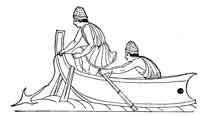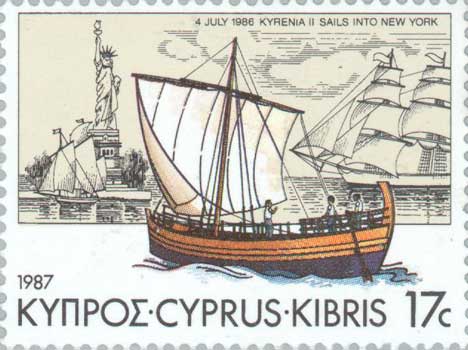.
Part 1
Wonders are many on earth, and the greatest of these
Is man, who rides the ocean and takes his way
Through the deeps, through wind-swept valleys of perilous seas
That surge and sway. Sophocles Antigone
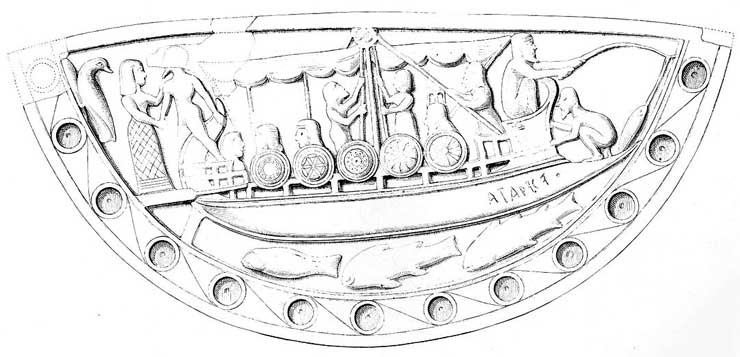
Ivory Plaque, Ship with warriors, one person fishing, three persons are adjusting the sail, on the left side a pair.
Greece has a very rich tradition in maritime trade. Under Greek or foreign flags Greek owners with their ships control around 16% of the world trade. The information about ancient Greek ships is very limited. The problem is that the wood with which these ships are built does not survive long enough in the sea. The lifetime of wooden ships is very limited as we for example know from various stories such as that of Columbus and his last voyage to America where he had problems that his ships after the long time in sea water were so much destroyed (eaten up by worms) that there was always a danger of sinking. After a few centuries sunken ships are eaten up by various organisms in the sea and therefore it is not surprising that almost none of the ancient Greek ships survived. We know what we know from literature sources such as from Homer describing Odysseus building a ship or from pottery images or from fresco paintings. Here the problem is how much these images (or text) are artistic and how much they represent the reality.
Ships
Neolithic period ships
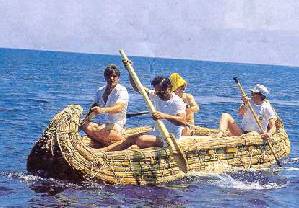
Image of a Papyrela Reconstruction
Around 7250 BC inhabitants of Greece traveled from the mainland to the island of Melos or Milos using papyrus boats (papyrela). The evidence is the discovery of obsidian pieces that exists only in Melos and which were found in the Greek mainland ( Franchthi cavern) and also in Cyprus. A reconstruction was used in an experiment in 1988. The experiment showed that the papyrela boat could be used for a travel from the island of Corfu to the Peloponesse. The information I have is that even until 1990 some fishermen used similar papyrus boats. http://www.gogreece.com/cuisine/images/payrela.jpg .
Form traces of men found on the island of Kefalonia living around 40000 BC we can guess that even much earlier boats have been used.
Minoan ship
Paintings that was found in Acrotiri in Thera (Santorini) show that the Minoans used various types of ships. The Minoans were the first navy power in Greece (that no palace fortifications were found is a sign of their sea-power).
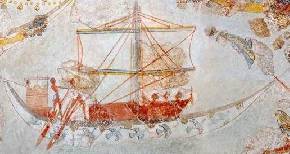
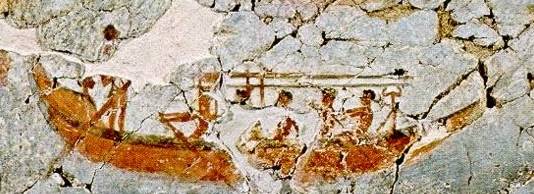
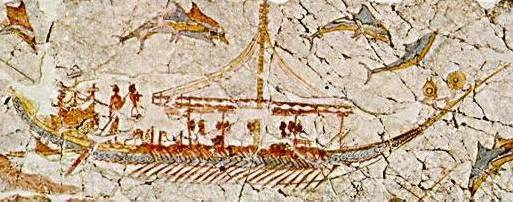
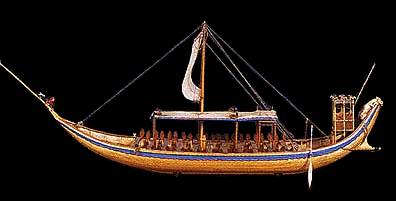
Various types of Minoan ships probably used around 1500 BC. The paintings are parts of a Fresco discovered by the Greek archaeologist Spyridon Marinatos in “Acrotiri”. Interesting is that there is no waterline visible and the ships look as floating over the water.
More details See: The Thera Fresco
The Ship Procession in the Miniature Fresco (PDF)
Images and reconstructions of Minoan Ships from the Maritime Museum in Crete The website in Greek). After 3500 years a minoan ship was reconstructed with a length of 17 meter and a width of 4 meter.
See: Minoan ship to set sail , Minoan vessel resurfaces , A model of a Minoan Ship (Two images of the reconstructed Minoan ship from a Greek website)
L. M. Brown, The Ship Procession in the Miniature Fresco, in C. Doumas, ed., Thera and the Aegean World (London, 1978) 629-44 (PDF File)
One of the first ship names we know are the Danais (Danos) and the Argo (Jason) named after her shipbuilder Argos (described as the long vessel). It was one of the first long vessel while before small round-shaped ships “strogulla” were used. The length of Argo was probably around 25 meters with 50-60 oars. The Greeks used the word tarsos ( a wing of a bird) for the oars and thus they were considered like the wings of a ship. The oars were used mainly in large numbers in military ships were speed was very important especially for the destruction of other ships with their ram. For trade ships it is not economical to have a large crew because it requires space and money. Therefore sails were used in trade ships.
The land within these folds of rock was so poorly clothed with soil that Plato later called the place "a fleshless skeleton." Grain would not grow readily here. .... Others decided on the risky business of adventure, took to the sea, and found more fertile footholds in coastal enclaves whose goods could bring a hefty price back in the newly-flourishing city-states of home, which badly needed grain and craved exotic luxuries. The colonists spread their web 2,300 miles from Mainica in Spain to Tanais in Russia. Howard Bloom Greece, Miletus and Thales - The Birth of the Boundary Breakers - 3000 BC to 550 BC
Homeric ship
939 BC. The ship Argo is built after the pattern of the long ship in which Danaus came into Greece: and this was the first long ship built by the Greeks. Chiron, who was born in the Golden Age, forms the Constellations for the use of the Argonauts; and places the Solstitial and Equinoctial Points in the fifteenth degrees or middies of the Constellations of Cancer, Chelae, Capricorn, and Aries. Meton in the year of Nabonassar 316, observed the Summer Solstice in the eighth degree of Cancer, and therefore the Solstice had then gone back seven degrees. It goes back one degree in about seventytwo years, and seven degrees in about 504 years. Count these years back from the year of Nabonassae 316, and they will place the Argonautic expedition about 936 years before Christ. Sir Isaac Newton, A short chronicle: From the First Memory of things in Europe to the Conquest of Persia by Alexander the Great
A pottery showing the Argos and the argonauts. (A list of all Argonauts)
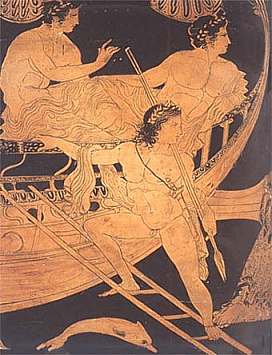
From Harry Thurston Peck. Harpers Dictionary of Classical Antiquities. New York. Harper and Brothers. 1898.:
The Homeric ship or galley had a sharp black hull, but was not as yet provided with a ram. The keel (τρόπις) was probably first laid upon short upright banks (δρύοχοι) of timber, laid level at suitable intervals. From the keel sprang the stem-post (στεῖρα), carried upward to a good height, as was also the stern-post. The sides (τοῖχοι) were held together by the thwarts (ζύγα), which formed the seats for the oarsmen. At the bow was a raised platform or deck (ἴκρια πρώρης), on which stood the fighting men of the ship; and there was a similar deck at the stern, on which the arms were kept, and under which there was room for stowage. The length of the fifty-oared galley is calculated to have been about 90 to 100 feet from stem to stern, with a breadth amidships of 10 to 12 feet. The galley was propelled by oars and sails together, the mast (ἱστός) being raised or lowered as stated above. When raised it was held in a sort of box (μεσόδμη), and kept in its place by forestays (πρότονοι). When lowered it rested on a sort of crutch (ἱστοδόκη). There was also a backstay (ἐπίτονος). The sail was hoisted on a yard (ἐπίκριον) having braces (ὑπέραι) and halyards (κάλοι). The sails were square in shape and white in colour. The ropes were of thong; but larger cables (ὅπλα) were made of byblus (Odyss. xxii. 391), occasionally of hemp or rushes (σπάρτα). The ship was steered by paddles (πηδάλια). The oars (ἐρετμά) were of fir-wood, the parts being the handle (κώπη) and blade (πηδόν). The oars were fastened to thowls (σκαλμοί) by thongs, and when not in use were drawn in, leaving the blade projecting. The master of the ship (κυβερνήτης) had his place on the forward deck. At times a long pole for pushing (κοντός) was used as an instrument of propulsion.
Up to 118 oarsmen according to Homer.
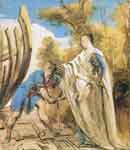
Calypso and Odysseus constructing a ship , Jacob Jordaens
...She gave him a great axe, fitted to his grasp, an axe of bronze double-edged, and with a goodly handle of olive wood fastened well. Next she gave him a polished adze, and she led the way to the border of the isle where tall trees grew, alder and poplar, and pine that reacheth unto heaven, seasoned long since and sere, that might lightly float for him. Now after she had shown him where the tall trees grew, Calypso, the fair goddess, departed homeward. And he set to cutting timber, and his work went busily. Twenty trees in all he felled, and then trimmed them with the axe of bronze, and deftly smoothed them, and over them made straight the line. Meanwhile Calypso, the fair goddess, brought him augers, so he bored each piece and jointed them together, and then made all fast with trenails and dowels. Wide as is the floor of a broad ship of burden, which some man well skilled in carpentry may trace him out, of such beam did Odysseus fashion his broad raft. And thereat he wrought, and set up the deckings, fitting them to the close-set uprights, and finished them off with long gunwales, and there he set a mast, and a yard-arm fitted thereto, and moreover he made him a rudder to guide the craft. And he fenced it with wattled osier withies from stem to stern, to be a bulwark against the wave, and piled up wood to back them. Meanwhile Calypso, the fair goddess, brought him web of cloth to make him sails; and these too he fashioned very skilfully. And he made fast therein braces and halyards and sheets, and at last he pushed the raft with levers down to the fair salt sea.It was the fourth day when he had accomplished all. Homer, Odyssey
http://www.perseus.tufts.edu/cgi-bin/image?lookup=1999.04.0062.fig01079 (Part of the Hull of an Homeric Ship)
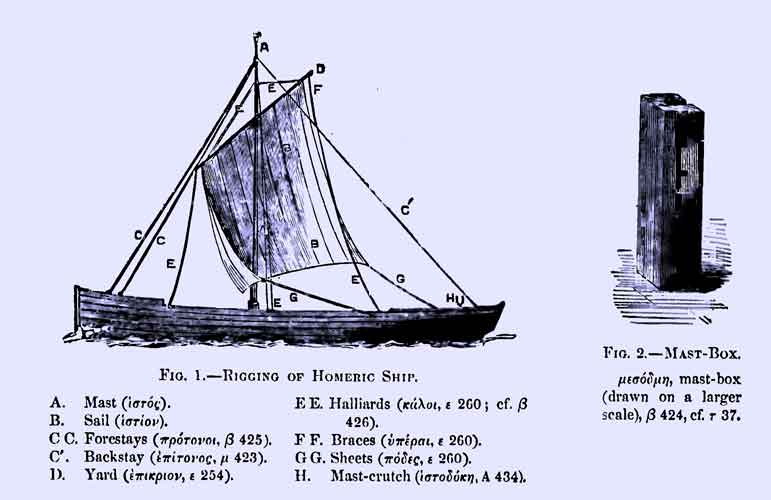
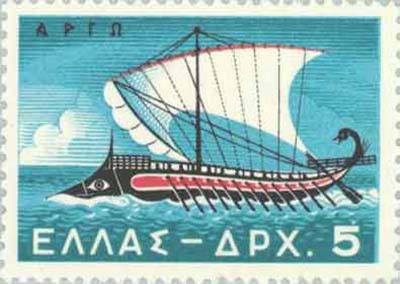
Argo, the ship of the Argonauts in a Greek stamp. The Argo ship was build in three months, but a modern reconstruction using only ancient tools after 15 months hard work could not finish even half of the c. 28 m long ship.
Argo and the Argonautic Expedition , Information about the Argonauts by Carlos Parada
Biremes and Triremes ships were military ships but versions were used also as transport ships by using a modified deck as oplitagagos for the transport of warriors or as ippagagos for the transport of horses.
Post-Homeric, Classical Period ships
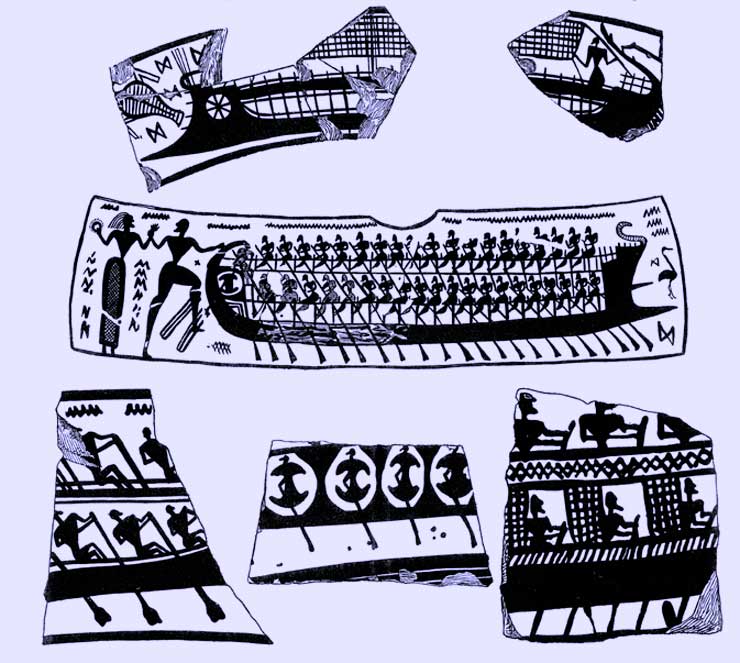
In the center, Image from a Lebes from Thebes, now in the British Museum
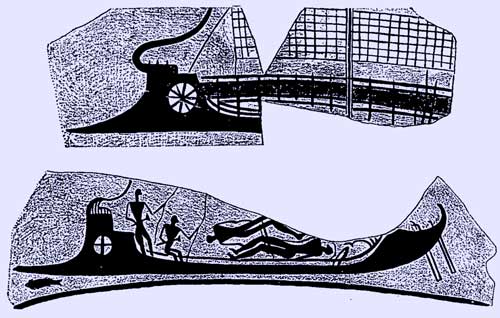
Archaic Pottery Ships images
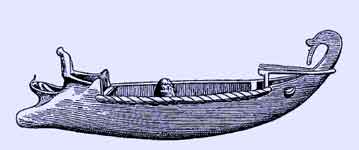
Object in form of a ship on the Acropolis, Athens 1862.
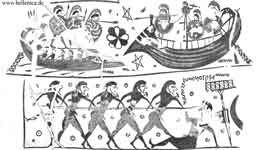
Sea battle from the Aristonothos Krater
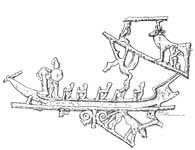
- Pentekonter
- Bireme
- Trireme
Information about the transition from the Penterkonter to the Biremes, Triremes to the giant ships
Hellenistic Period ships
A large number of trade ships was used as only the Athenians had to transport around 150000 tons grain per year. Again the problem is that almost none of these ships survived in our times but there are a few exceptions when the wrack was covered with some sea ground material. Such a case was the so called Kyrenia ship that was discovered 1968 in Cyprus, a version of a trade ship used in the Hellenistic times. The Kyrenia ship as experts have found was used for around 80 years and they assume that it was for three generations owned by a family of shipowners (naukleroi). It was possible to find that one of the ship trading routes was Samos - Kos - Rhodes - Cyprus , probably not more than 4 sailors were needed. It carried more than 400 Amphoras.
-
Greek Commercial Ship c. 300 BC , The Kyrenia Trade Ship (A Reconstruction Image)
http://www.perseus.tufts.edu/cgi-bin/image?lookup=1999.04.0062.fig01080_3 Trading-ship. (From a Vase in the British Museum.)
During the Hellenistic period also some gigantic ships were build. One famous example of such a ship is the Syracusia that is known because Archimedes was able to move it with his machines. This ship was later renamed to Alexandria.
- Harbour (Limen, pl. Limenes), Closed Harbours (Limenes Kleistoi)
- Breakwater, Mole (Choma, Chele)
- Ship sheds (Neosoikoi)
- Lighthouse (Pharos)
- Dockyards (Naupegia)
- Arsenals (for storing oars, sails) (Skeuothekae)
| Ancient Greece
Science, Technology , Medicine , Warfare, , Biographies , Life , Cities/Places/Maps , Arts , Literature , Philosophy ,Olympics, Mythology , History , Images Medieval Greece / Byzantine Empire Science, Technology, Arts, , Warfare , Literature, Biographies, Icons, History Modern Greece Cities, Islands, Regions, Fauna/Flora ,Biographies , History , Warfare, Science/Technology, Literature, Music , Arts , Film/Actors , Sport , Fashion --- |

